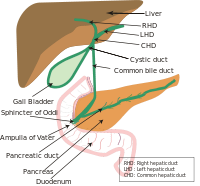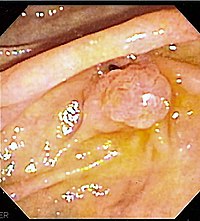Theampulla of Vater,hepatopancreatic ampullaorhepatopancreatic ductis the common duct that is usually formed by a union of thecommon bile ductand thepancreatic ductwithin the wall of theduodenum.This common duct usually features a dilation ( "ampulla"). The common duct then opens medially into the descending part of the duodenum at themajor duodenal papilla.The common duct usually measures 2-10mm in length.[1]
| Ampulla of Vater | |
|---|---|
 A diagram of thebiliary system.Note that the ampulla of Vater is behind themajor duodenal papilla. | |
 Themajor duodenal papilla,seen on duodenoscopy at the time ofERCP.This is the protrusion of the ampulla of Vater into the duodenum. | |
| Details | |
| Identifiers | |
| Latin | ampulla hepatopancreatica, ampulla Vaterii |
| MeSH | D014670 |
| TA98 | A05.8.02.017 |
| TA2 | 3111 |
| FMA | 15076 |
| Anatomical terminology | |
The ampulla of Vater is an important landmark halfway along the second part of theduodenummarking the transition fromforeguttomidgut.[citation needed]
Structure
edit2.Intrahepatic bile ducts
3.Left and right hepatic ducts
4.Common hepatic duct
5.Cystic duct
6.Common bile duct
7.Ampulla of Vater
8.Major duodenal papilla
9.Gallbladder
10–11.Rightandleftlobes ofliver
12.Spleen
13.Esophagus
14.Stomach
15.Pancreas:
16.Accessory pancreatic duct
17.Pancreatic duct
18.Small intestine:
19.Duodenum
20.Jejunum
21–22. Right and leftkidneys
The front border of the liver has been lifted up (brown arrow).[2]
Sphincters
editVarioussmooth musclesphinctersregulate the flow ofbileandpancreatic juicethrough the ampulla: thesphincter of the pancreatic duct,thesphincter of the bile duct,and thesphincter of Oddi.[3]
Variation
editThe common bile duct and pancreatic duct may sometimes unite outside the duodenal wall, creating an unusually long common duct. The two ducts may also drain into the duodenum separately, or may fuse yet retain their separate lumens separated by a septum.[1]
Clinical significance
editThomas' signis the production ofsilver stoolsand can be indicative ofcancer of the Ampulla of Vater.The ampulla of Vater is the site of tumors, often with a threatening prognosis and difficult surgical treatment. The silver-colored stool is a combination of the white stool of obstructive jaundice combined with black stool of melena or bleeding. It was first described in theBritish Medical Journalby Dr. H. Ogilvie in 1955.[4]
Etymology
editThe eponymic term "ampulla of Vater" is named afterAbraham Vater(1684–1751),[5]aGermananatomistwho first published a description of it in 1723.[6]
Additional images
edit-
The pancreatic duct.
-
Carcinoma of Ampulla
References
edit- ^abStandring, Susan (2020).Gray's Anatomy: The Anatomical Basis of Clinical Practice(42nd ed.). New York. p. 1219.ISBN978-0-7020-7707-4.OCLC1201341621.
{{cite book}}:CS1 maint: location missing publisher (link) - ^Standring S, Borley NR, eds. (2008).Gray's anatomy: the anatomical basis of clinical practice.Brown JL, Moore LA (40th ed.). London: Churchill Livingstone. pp. 1163, 1177, 1185–6.ISBN978-0-8089-2371-8.
- ^Allescher, H. D. (1989)."Papilla of Vater: Structure and Function".Endoscopy.21(S 1): 324–329.doi:10.1055/s-2007-1012982.PMID2691236.S2CID38457896.Archived fromthe originalon June 2, 2018.RetrievedMarch 27,2020– via www.thieme-connect.de.
- ^Ogilvie, H (1955)."Thomas's sign, or the silver stool in cancer of the ampulla of Vater".Br Med J.1(4907): 208.doi:10.1136/bmj.1.4907.208.PMC2060824.PMID13219383.
- ^Lerch, MM; Domschke, W (2000)."Abraham Vater of the ampulla (papilla) of Vater".Gastroenterology.118(2): 379.doi:10.1016/s0016-5085(00)70243-5.PMID10691372.
- ^Vater A. Dissertation in auguralis medica, poes diss. Qua Scirris viscerum dissert, C.S. Ezlerus. Vol 70. 1723.
- "Ampulla, hepatopancreatic."Stedman's Medical Dictionary, 27th ed.(2000).ISBN0-683-40007-X
- Moore, Keith L. and Arthur F. Dalley.Clinically Oriented Anatomy, 4th ed.(1999).ISBN0-683-06141-0